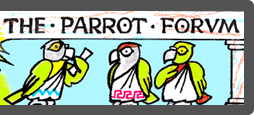Pajarita wrote:I wouldn't put a harness on any of the small aviary species. There is no benefit to them - only stress and discomfort.
I have no idea what a "small aviary species" is. All parrots can be trained to wear a harness and not be stressed or uncomfortable. Training isn't the issue and species isn't the issue. The issues are that most people don't give adequate love, training, and expense to the smaller birds so they come off as wild. However, if someone would spend the effort hand feeding, raising, and training a lovebird as they do a macaw, it wouldn't be much different. The other issue is just a scale issue. Our hands are proportionately bigger to a lovebird than to a macaw. Likewise, the manmade harness straps, buckles, and materials are huge to the small bird. The harnesses are not properly scaled down for size. They are just taking a big bird harness and making the collar smaller while the thickness of the material is the same. Therefore it's like a toddler trying to wear a man's Tshirt. It's out of proportion. Last issue is that the small birds live at a much quicker pace. It's hard for us to keep up with them when it comes to training and particularly something like harness training. In the 1 second of approaching with harness, the bird has looked in ten different directions and ran back and forth on the perch. Our scale of time just makes it a very strong burden on the trainer to move quickly and efficiently to keep up with the bird and to have the dexterity and gentleness in our hands to work with the scale. Otherwise, I don't see them as just aviary birds or anything less. It's our fault, not theirs.








